Health
The Concrete Enema
It provided the title for Chuck’s classic 1996 collection of weird news (and if you don't have Chuck's book you really should do yourself a favor and get it. It deserves to be in every home library). However, we’ve never posted about the incident itself here on WU. So I thought I'd remedy that oversight.In 1987, two doctors reported an unusual case in The American Journal of Forensic Medicine and Pathology. It involved a 20-year-old man who had shown up at an emergency room complaining of rectal pain. Examination of his rectum revealed a “hard stony mass,” and eventually the patient disclosed how the mass had gotten there:

Remarkably, the doctors were able to remove the concrete mass without any damage to the patient's rectum. It had formed a perfect cast of the interior of the rectum, even showing “grooves produced by mucosal folds.”
Removal revealed another unusual detail: a ping-pong ball mixed in with the concrete. Apparently the patient didn’t explain what the ball was doing there. The doctors hypothesized that it had been "inserted after the enema as a plug to promote retention… Instead, peristaltic contractions forced the air-filled plastic ball deeper into the hardening concrete, accounting for its location in the upper end of the mass."

After resting overnight, the patient was able to leave the hospital the following morning, no worse for wear. One can only hope that he had learned a valuable life lesson: that it's really not a good idea to use concrete as an enema.
I wonder what became of the concrete enema. Was it thrown away in the trash? This seems most likely. Or perhaps it's sitting in a box in a medical archive. Or, and this is my favorite idea, perhaps one of the doctors saved it to use as a paperweight. Whatever the case may be, if it still survives it definitely would be a great exhibit to include in a museum of the weird.
More info: Peter J. Stephens and Mark L. Taff. (1987). “Rectal Impaction Following Enema with Concrete Mix.” The American Journal of Forensic Medicine and Pathology, 8(2): 179-182.
Posted By: Alex - Wed Aug 28, 2019 -
Comments (0)
Category: Health, Sex Toys, 1980s
Youngster got high on hamburgers
A strange affliction to suffer from.
The Alexandria Town Talk - Jan 14, 1976
Posted By: Alex - Mon Aug 12, 2019 -
Comments (2)
Category: Food, Health, 1970s
Signs of Health
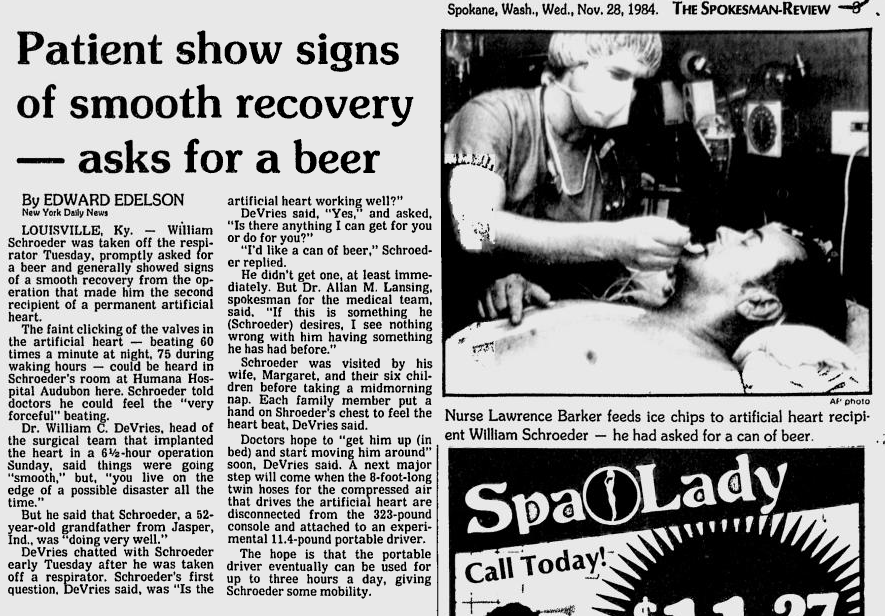
Alas, this positive sign was not an accurate forecast of the fate of William Schroeder.
Article source.
Posted By: Paul - Wed Jul 10, 2019 -
Comments (2)
Category: Body, Death, Health, Surgery, 1980s, Alcohol
How to Catch a Cold
Disney and Kleenex: a match made in...Madison Avenue?Plus: excess square-dancing opens you up to germs.
Posted By: Paul - Tue Mar 26, 2019 -
Comments (0)
Category: Body, Business, Advertising, Health, Disease, PSA’s, 1950s
Pre-Infected Tissues
The company Vaev claims to be selling tissues that have already been sneezed into. For about $80 it seems that you get a box containing one infected tissue. The idea apparently is that you can infect yourself with a cold, and this will somehow strengthen your immune system, thereby protecting you from further colds or the flu. Although the company's website is very vague on details, offering only this:The idea is so odd that I wonder if it isn't some kind of hoax. Note that it isn't actually possible to buy these things because the company's online store claims to be sold out.
More details at Yahoo News!.
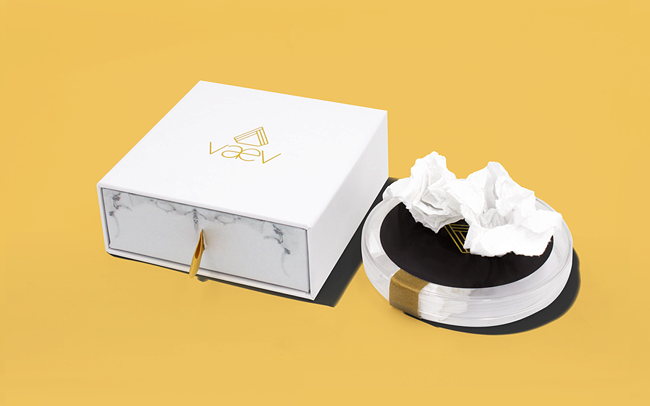
Posted By: Alex - Thu Jan 24, 2019 -
Comments (4)
Category: Health, Disease, Overpriced Merchandise, Cures for the common cold
Inductive Nasal Device
Norman Lake's cure for the common cold. Otherwise known as the "IND".More info: Chicago Tribune - Nov 20, 1985
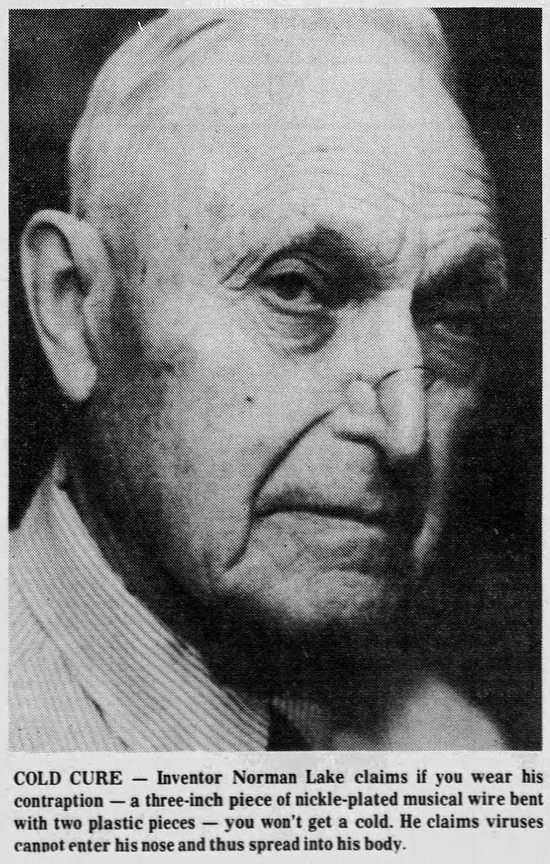
Chambersburg Public Opinion - Apr 23, 1982
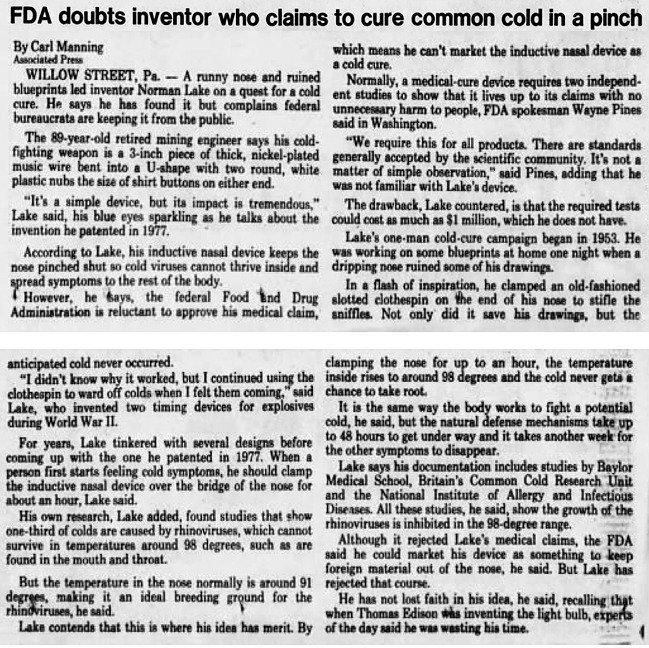
Arizona Republic - May 8, 1982
Posted By: Alex - Mon Sep 10, 2018 -
Comments (1)
Category: Health, Inventions, Cures for the common cold, 1980s
Eye worm art
Artist Ben Taylor drew a painting that featured “psychedelic colors and wormlike patterns inside a perfectly round circle.” Only later did he realize that he had parasitic worms in his eye, and he thinks they might have subconsciously inspired him. From The Durango Herald:He later adapted his painting to make it more obviously an eye infected by parasitic worms, and as a result it’s been chosen as the cover art for this month’s issue of Emerging Infectious Diseases.

Posted By: Alex - Mon Aug 13, 2018 -
Comments (2)
Category: Art, Health, Disease, Eyes and Vision
Motion-Sickness Glasses
They're called SEETROËN glasses. They were designed by the French car company Citroën, which claims that they're the first glasses that eliminate motion sickness. Apparently the blue liquid in the glasses simulates level ground, which helps stop the vertigo feeling that some people get while traveling.Interesting concept, but they look a lot like "crazy straw" glasses.
More info: visuall.net

Posted By: Alex - Tue Jul 17, 2018 -
Comments (3)
Category: Fashion, Health, Inventions
Dung Lung
Death by breathing in dung fumes. It doesn't sound like a pleasant way to go, though perhaps not the worst since apparently before it kills you it paralyzes your sense of smell. But it's definitely a weird way to die.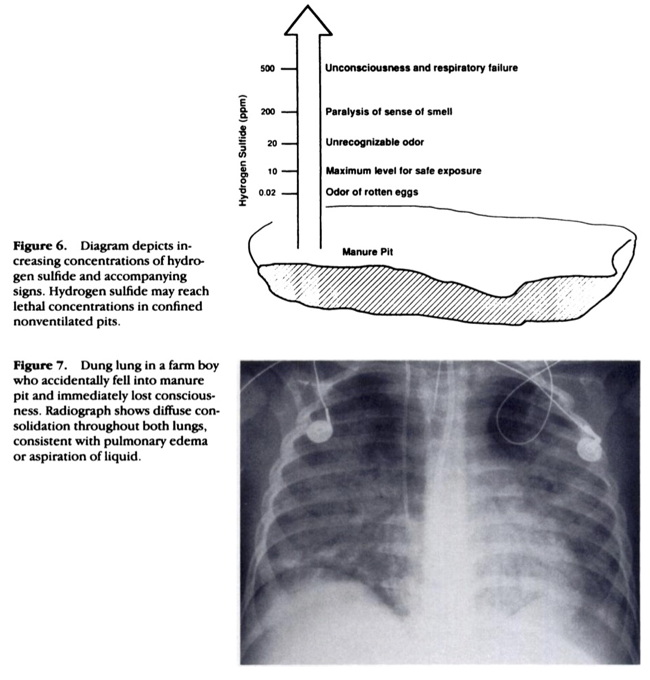
“Agricultural Disorders of the Lung,” RadioGraphics (1991); 11:625-634.

Mansfield News-Journal - Sep 24, 1982
Posted By: Alex - Mon Jul 09, 2018 -
Comments (3)
Category: Death, Health, Excrement
Opposed cream in coffee
The French scholar Arsene Thiebaud de Berneaud liked his coffee black. So much so that he "opposed with ferocity the then comparatively new custom of adding milk or cream to black coffee.""He seems to have had an obsession that all mixtures of fluids were injurious... Sustained by this preconceived notion, he was able to publish a long diatribe in 1826, in which he accuses cafe au lait of causing almost every derangement known to medicine."
I've been able to find almost no other information about de Berneaud, so this one odd theory seems to be the most enduring thing he left behind.
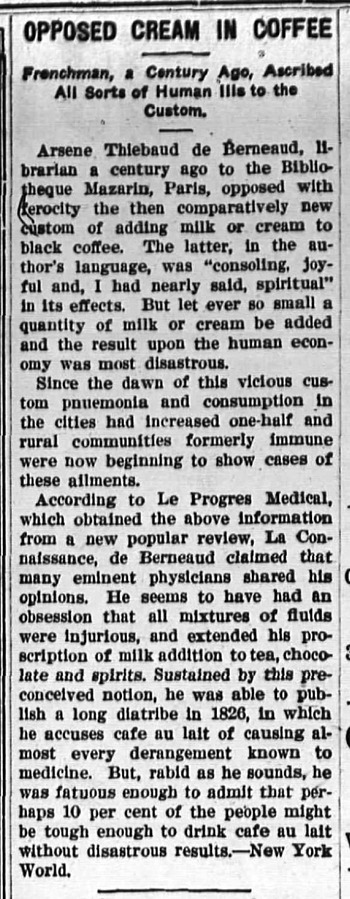
The Chatham Press - July 15, 1922
Posted By: Alex - Wed Jun 27, 2018 -
Comments (5)
Category: Health, Weird Theory, Coffee and other Legal Stimulants, Nineteenth Century

| Who We Are |
|---|
| Alex Boese Alex is the creator and curator of the Museum of Hoaxes. He's also the author of various weird, non-fiction, science-themed books such as Elephants on Acid and Psychedelic Apes. Paul Di Filippo Paul has been paid to put weird ideas into fictional form for over thirty years, in his career as a noted science fiction writer. He has recently begun blogging on many curious topics with three fellow writers at The Inferior 4+1. Contact Us |





